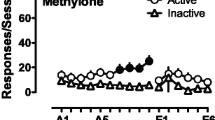Abstract
Rationale: Dextromethorphan (DXM) and its metabolite, dextrorphan (DXO) have neuroprotective and anticonvulsant properties through their activity as N-methyl-d-aspartate (NMDA) receptor channel blockers. Based on this receptor activity, coupled with reports of DXM abuse, both were evaluated for abuse potential and phencyclidine (PCP)-like behavioral effects in two animal models. Objectives and methods: The discriminative stimulus properties of DXO and DXM were tested in rats (3–56 mg/kg DXM, i.p. and 2.2–40.9 mg/kg DXO, i.p.) and rhesus monkeys (0.3–10 mg/kg DXM, i.m. and 0.25–8.0 mg/kg DXO, i.m.) trained to discriminate PCP from saline using a standard two-lever drug-discrimination paradigm under a fixed-ratio (FR) schedule of food reinforcement. In a second set of experiments, i.v. self-administration of DXO (10–100 µg/kg/infusion) and DXM (10–1000 µg/kg/infusion) were tested under a FR schedule of reinforcement in monkeys trained to lever press for infusions of PCP during daily 1-h sessions. Results: In rats, both DXM and DXO produced a dose-dependent substitution for PCP. When tested in monkeys, DXM yielded partial (1 monkey) and full (2 monkeys) substitution for PCP, while DXO substituted fully for PCP in all four subjects tested. In the self-administration study, in five of the six subjects, at least one dose of DXM served as a positive reinforcer, maintaining infusion rates above those for saline. For DXO, at least one dose maintained infusion numbers well above mean saline infusion numbers in all subjects. Conclusions: Taken together, these data show that DXM has some PCP-like effects in rats and monkeys, but that they are more reliably produced by its metabolite, DXO. Thus, high doses of DXM may have some PCP-like abuse potential in humans but this potential may be associated with, or enhanced by, metabolism of DXM to DXO.
Similar content being viewed by others

Author information
Authors and Affiliations
Additional information
Received: 30 November 1998 / Final version: 25 March 1999
Rights and permissions
About this article
Cite this article
Nicholson, K., Hayes, B. & Balster, R. Evaluation of the reinforcing properties and phencyclidine-like discriminative stimulus effects of dextromethorphan and dextrorphan in rats and rhesus monkeys. Psychopharmacology 146, 49–59 (1999). https://doi.org/10.1007/s002130051087
Issue Date:
DOI: https://doi.org/10.1007/s002130051087



